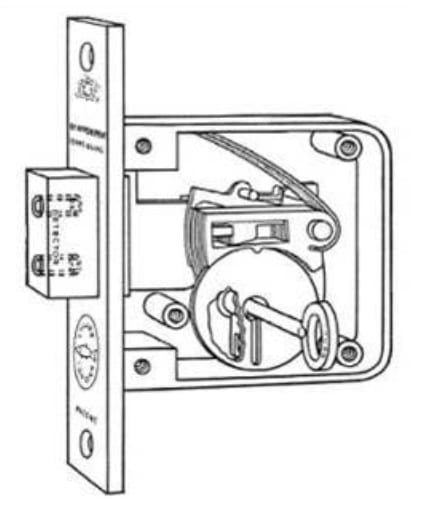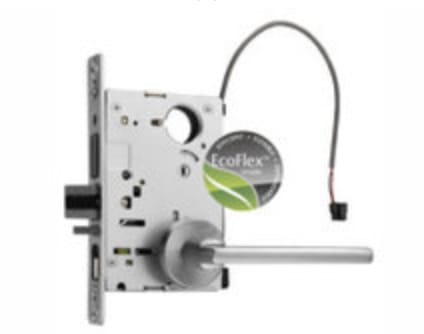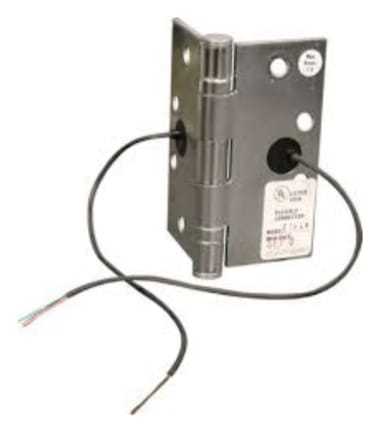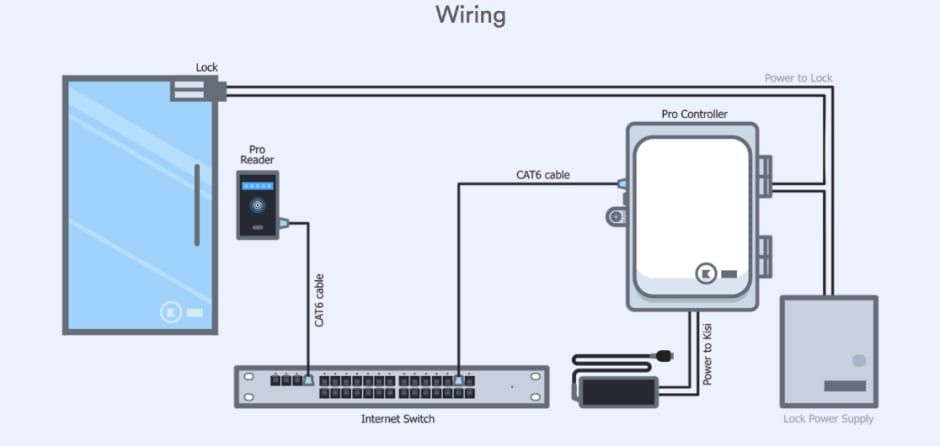If you have a door you’re looking to secure, and you want something more modern than an older analog lock, electric locks are the natural progression. In this article, we’ll take a look at the wired electrical locks wired mortise. For a more broad introduction to the topic, check out this guide on the Kisi blog.
How a Mortise Lock Works
In this section, we’ll explore the tech behind a mortise lock, and see how to install it on the premises.
The “Moving Parts” of a Regular Mortise Lock
A mortise lock isn’t inherently electric. It is a mechanism that sits inside the door itself, and has the bare minimum of parts: a key cylinder, some pulleys, and a bolt that locks the door. What sets a mortise lock apart from the other kinds that we’ve explored in this course is the fact that everything is installed inside the door itself rather than on the frame, making it very sleek and elegant as there are no outwardly visible parts (as long as the door isn’t made of glass!)

As the name of this article suggests, you can also add electricity to the mix to take the lock to the next level. The electricity can be wired into the latch system, adding a second method of pulling the door bolt. Most installers would still recommend keeping the analog key cylinder as a backup, but an electrical impulse from the wiring would also suffice to pull the bolt and unlock the door.
Fail-Secure Mechanism
A mortise lock is a fail-secure lock, meaning that when the power is out, it will stay locked. The default position will be for the latch to be ‘activated’ (sticking out, into the door frame), and it will remain so until it is triggered, even if the power goes out.

This makes it an attractive option for those doors that secure sensitive areas, like IT rooms or records rooms. While you certainly don’t want this on any door that’s part of an emergency exit route, if you have a room that should remain locked at all times even in the case of a power outage, an electronic mortise lock is a good bet.
How to Install It
A mortise lock is generally a bit more involved, as you will need to cut out the mold in the door itself. Of course, if your door already has a mortise lock, then upgrading to an electronic mortise lock is super straightforward — you can just replace the existing one with an electric one of similar dimensions, and there is no need to change anything else. For a good, reliable electronic mortise lock, Kisi recommends the Schlage L series. You can find complete installation info and data sheets at that link!
Once you’ve installed the lock in the door, you will have cabling to account for as well. At this point, you’ll have a decision to make: Whether to run the cables inside the door, or outside of it. The former option is a bit more difficult, as it requires more work carving out the space for them, but it is certainly more elegant and visually pleasing than the latter. If you prefer the cables to be hidden, there are actually electrified door hinges that can help reduce the footprint of the cabling. Consult with an installer on location for a more personalized opinion!

How to Test It
Once you’ve got it installed, you will of course want to make sure that the lock is functioning properly. With such a simple lock, there will thankfully be only two components to test: the analog key lock mechanism, and the electronic unlocking.
The former is simply accomplished by trying out the backup key that your installer or manufacturer furnished you with. For the latter, you will need to connect the wires to the power supply and access control systems that you’ve opted for, and attempt an unlock. More on access control later in this article!
Other Things to Look out for During the Installation
Given that the mortise lock is a fail-secure lock, you will have to make sure that it’s never an impediment to an emergency exit for the building (or if it is on an exit route, you’ll want a panic push bar on the door beside it). In addition, you should check with fire marshals to ensure that you’re adhering to all relevant codes. While the codes differ based on the city and the type of building, there are many commonalities, and Kisi has a handy guide to help you figure out what you need for your space.
Electronic locks for access control systems
Learn about different types of locks and their installation.
How a Mortise Lock is Unlocked Using an Access Control System
In this section we’ll give a basic overview of how electronic mortise locks integrate with the most modern IP access control readers like Kisi.
Wiring
Given that it’s an electric lock, and that electric impulses run through wires, the electronic mortise lock will have to be wired to both a power supply and, by extension, to the access control reader/controller. Its simple nature means that in most cases it doesn’t have Wifi or other wireless capabilities, so this wiring is essential for its functioning.

This diagram is a basic representation of how a Kisi controller is wired to an electronic lock (a maglock in the diagram, though the principle is the exact same for a mortise lock). The controller receives authentication info from the reader, and relays a signal to the power supply, which then sends an impulse to the lock, thus unlocking it.
Unlocking
If you opt for a modern IP access control system like Kisi, unlocking will be done all over mobile, or access cards if you prefer those. With the wiring described here, you will present your credentials, to the reader (tap your phone or access card to it), and the authentication process will begin.
Behind the scenes, at this point, the reader will take the Bluetooth or NFC signal from your phone and pass it along to the controller on a Bluetooth or Wifi signal. As mentioned in the previous section, if the controller authenticates the signal successfully, a signal will be sent to the lock power supply to activate electricity to the lock, thus unlocking it for a short period of time.
Concluding Thoughts
Wired mortise locks are at their core just a beefed up version of a classic bolt lock that has been in circulation for a long time. They have a sleek silhouette, and can be installed in such a way as to preserve the aesthetic appeal of any door, as long as it’s not glass. Their fail-secure mechanism also means that they will stay locked even in the case of a power outage, making them ideal for protecting sensitive areas.
Save time. Enhance security.
Modernize your access control with remote management and useful integrations.

